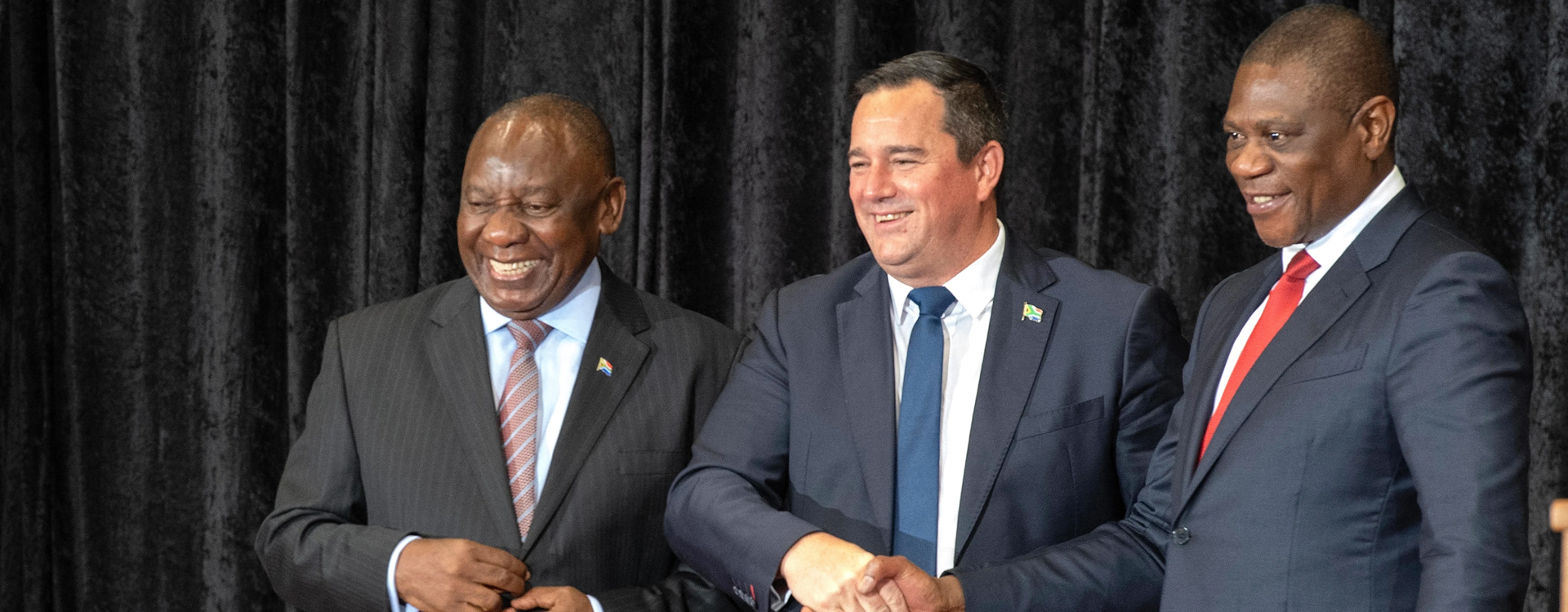To the GNU and beyond - South Africa’s long-term development prospects

What is South Africa’s full potential if the GNU rallies behind pro-growth strategies and delivers on critical structural reforms?
South Africa’s post-apartheid journey has been a mix of milestones and setbacks. While the early 1990s delivered political freedom, the subsequent decades have been marred by economic stagnation and social challenges. Since 2007, a series of both external shocks and self-inflicted crises has severely slowed GDP per capita growth. By 2023, this figure had fallen to 8% below its 2013 peak.
However, the establishment of the Government of National Unity (GNU) has reignited hope and optimism across the country. This broad coalition of ten political parties, under the leadership of the ANC’s President Cyril Ramaphosa, is focused on fostering inclusive growth and driving long-term economic recovery. The key question is: what is South Africa’s full potential if the GNU rallies behind pro-growth strategies and delivers on the critical structural reforms?
To explore this, we’ve modelled South Africa’s long-term growth prospects to 2043.
Our analysis begins by considering the country’s likely growth trajectory under a business-as-usual scenario. On this path, South Africa would only recover its 2013 peak GDP per capita by 2036, implying 23 lost years of economic progress, much of which can be attributed to the devastating effects of state capture during the Zuma administration on top of COVID-19 shortly thereafter. Growth is forecast to average just 1.8% annually from 2024 to 2030, despite an economy that is 17% larger by 2030 than in the business-as-usual scenario. Yet, South Africa continues to lose ground compared to other upper-middle-income countries. Unless there are significant shifts in governance, infrastructure investment and economic policy, the country will continue to underperform.
We then compare this baseline forecast with the impact of eight sectoral scenarios, including Demographics and Health, Agriculture, Education, Manufacturing, Free Trade, Large Infrastructure and Leapfrogging, Financial Flows, and Governance. Each scenario is benchmarked against countries at similar levels of development, offering a reasonable but ambitious aspiration in each sector. Finally, we combine the eight scenarios into a single combined scenario to evaluate what could happen if all these positive changes occurred simultaneously.
In the Combined scenario, South Africa could recover its 2013 GDP per capita by 2030, some six years earlier than on the current trajectory. This would align with the 2029 national elections, at which time the GNU’s success in driving structural reforms will be under scrutiny. While recovery may take longer than expected, by 2029, it could deliver tangible benefits to many South Africans.
The National Treasury has estimated that 35% of the growth slowdown from 2007 to 2021 can be attributed to the underperformance of critical network industries such as electricity, rail and telecommunications. These sectors have significantly impacted the broader economy and constrained trade, making them the focus of Operation Vulindlela, the presidential initiative to accelerate structural reforms.
Our analysis emphasises the need for substantial investment in these sectors, including opportunities for private-sector involvement in running South Africa’s ports and a focus on shifting more freight transport from road to rail to ease congestion and reduce logistics costs. These infrastructure investments would enable the Free Trade scenario to maximize its potential, driving both economic growth and poverty reduction.
Our analysis emphasises the need for substantial investment in sectors such as electricity, rail and telecommunications together with private-sector involvement in running South Africa’s ports
Our forecast indicates that by focusing on rapid renewable energy expansion, utilising natural gas resources, an additional nuclear build, and modernising the grid, South Africa could significantly enhance its energy security. However, achieving long-term sustainability will require prioritised infrastructure investments and diversifying the energy mix beyond its ageing coal fleet. This approach will reduce the country’s reliance on coal and create a more resilient energy system, capable of meeting growing industrial and residential demand.
Our analysis confirms the potential economic impact of the African Continental Free Trade Area (AfCFTA) on South Africa’s development. Proximity to rapidly growing neighbouring markets and the potential for increased intra-African trade could stimulate growth and reduce poverty.
South Africa must actively pursue an export-led growth path by reducing high investment costs, improving ease of trading across borders, and adopting a more effective export promotion strategy. Key to this is upgrading infrastructure, including integrating into the Pan-African Payment and Settlement System (PAPSS) to simplify trade in African currencies and reduce reliance on third-party currencies like the US dollar.
Poor human capital remains the largest structural constraint on South Africa’s growth. As our forecasting highlights, the lingering effects of HIV/AIDS, coupled with a weak education system, have resulted in a poorly skilled workforce. The need for improvements in education and healthcare is paramount, but these changes will take longer to materialise than in other sectors.
However, despite every effort to stimulate growth, reflected in our modelling, poverty levels are anticipated to remain stubbornly high, even under the Combined scenario. The percentage of South Africans living below the upper-middle-income poverty line of US$6.85 per day is forecast to remain at 63% through 2029. This points to the critical importance of facilitating growth in the informal sector, which could provide better livelihoods for millions of poor South Africans. The formalisation and expansion of this sector, alongside job creation through infrastructure development, will be essential for poverty reduction.
South Africa has an abundance of well-crafted plans and strategies, but the lack of implementation and accountability continues to hamper progress. As Deputy President Paul Mashatile said in a speech at the University of Johannesburg on 26 July 2024, “Our nation possesses sound policies, but we struggle with execution due to a deficiency in accountability.” For the GNU to succeed, it must ensure that policies are not just formulated but meticulously implemented, particularly in critical sectors like infrastructure. The responsibility for these improvements lies, in the first instance, at the door of the country’s political leadership. When the Johannesburg Centre for Development and Enterprise published the first of its series of reports some months ago on what the seventh administration should do, it, therefore, started with the need to reorganise the Presidency and the cabinet.
Given its history, it is perhaps to be expected that the lack of national coherence is a huge problem in South Africa, reflected in our racially determined politics and extreme levels of inequality. The country needs a government committed to an inclusive non-racial vision and a forward-looking leadership ethos - a shift to a class-based rather than a race-based analysis that champions the cause of all poor and unemployed people (the vast majority of whom are black), and the advancement of investment and entrepreneurship of all South Africans, while maintaining a focus on interventions that assist the previously disadvantaged groupings - steadily shifting the focus to empowerment and away from hand-outs where possible.
The country needs a government committed to an inclusive non-racial vision and a forward-looking leadership ethos
Accountable and competent leadership that pursues evidence-based policies will allow the South African economy to create jobs and eventually reduce inequality - something that can only happen if the economy grows much more rapidly than currently. Therefore, it is no surprise that our scenario on the impact of better governance is the second most impactful lever for reducing extreme poverty and increasing incomes.
The report, which will be launched on 17 September in partnership with News24 and the Hanns Seidel Foundation, is available here.
Image: RODGER BOSCH/AFP via Getty Images
This analysis is also published by News24.







